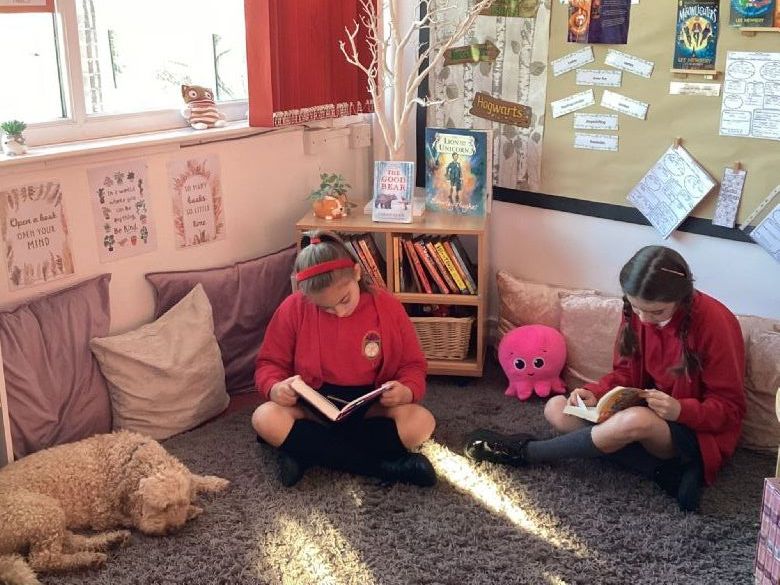Reading
Intent (Why we learn…)
At St Saviours, reading is a fundamental part of the curriculum as it has been described as the skill that unlocks all areas of the curriculum. We believe that every child deserves and has the right to become a competent reader and, through high-quality teaching and learning, aim to provide children with the appropriate reading skills to allow them to succeed in all areas of the curriculum and in future life.
These are:
- To be enthusiastic, inquisitive, lifelong learners: we aim to inspire lifelong readers with an intrinsic love of reading through using a wide range of high-quality books to build a positive culture of reading for pleasure where book talk, sharing and celebrating stories is an inherent part of school life.
- To be strong communicators: we provide reading opportunities which create a powerful tool to support effective communication by: using books explore and learn more about the world around them; using books to introduce rich vocabulary and using stories to enrich children’s speaking and listening skills.
- To be well-rounded, independent and resilient learners with aspirations: we provide children with the tools and confidence to be resilient and independent readers. As part of high-quality teaching, we promote a love of reading for all pupils and give children the key reading skills. This allows them to access all areas of the curriculum with independence and confidence and encourages children to feel inspired by experiences and knowledge acquired through reading ensuring high aspirations to go on to be successful throughout their lives.
- To develop and use their God given talents by being creative: through embedding reading as an inherent part of the curriculum, we aim to foster intrinsic love for reading, promoting and encouraging children to use reading as a pathway to inspire their imagination, curiosity and discover their passions.
- To be responsible citizens who are eager to make a positive contribution to their community and wider society: we encourage children to ask and answer questions about the world around them. Using reading, we provide opportunities for children to learn about the world, their community and wider society, and how books can be used as a tool to inspire positive change.
Implementation (How we teach...)
At St Saviour’s we ensure high expectations for all. Our reading curriculum is varied and inclusive for all pupils. Lessons are taught for depth and mastery ensuring that all children are given the tools and support needed to reach at least age-related expectations.
Using the National Curriculum and adapted units from Jane Considine’s Hooked on Books, we have carefully mapped out texts which cover a wide range of themes and genres ensuring that every child becomes a fluent, confident and enthusiastic reader with opportunities to read, comprehend, discuss, share and listen to stories. Our curriculum map ensures high-quality texts and relevant and engaging units of work for all year groups which include cohesively sequenced lessons ensuring that prior learning is revisited and developed both within year groups and year on year.
Our curriculum is built upon the foundations of a reading for pleasure culture where the children are inspired to read through memorable, diverse and rich opportunities. We utilise the school environment to ensure high-quality, inviting reading areas and displays which celebrate books. We also hold whole school events and competitions such as reading challenges, book fairs, World Book Day activities, author days and themed reading days to bring books to life and to enhance children’s learning experiences.
Throughout daily lessons, we ensure quality first teaching for all children by ensuring that, wherever possible, support and feedback is given at the point of learning. Each unit of work ensures full coverage of different skills which allow children to become both fluent in their reading and confident in their comprehension.
The use of robust, ongoing assessment for learning (AfL) informs future planning and identifies where further individual or group support this needed. We identify SEN children and identify any gaps in learning to put in place clear, rigorous interventions such as pre-reading, additional lessons, Looking and Thinking tasks and the Little Wandle Rapid Catch-up program.
To track pupil progress and attainment in reading, each child completes a termly fluency assessment and a half termly comprehension reading assessment. These assessments, alongside teacher AfL, form the summative assessment data which is collated on Sonar. We then use this data to track pupil progress and attainment.
The subject leader participates in regular, up-to-date training to ensure they have a clear understanding of their roles and responsibilities alongside the knowledge, expertise and practical skills to carry out this role to the best of their ability.
Impact (As a result…)
The impact of our school’s reading curriculum can be seen in the pupils’ books, summative data collected on Sonar and through pupil voice. Strong relationships, alongside a positive reading for pleasure culture where a love for reading is instilled and celebrated, are kept at the centre of everything we do. As a result, outcomes for all groups of pupils within reading are improving.
Pupils’ progress is measured through ongoing assessments and three key assessment points during the year. Pupil data is then analysed against both internal and external data to ensure progress is on track in each year group. From this, interventions are planned, implemented and evaluated for targeted pupils. Intervention tasks such as pre-reading, Rapid Catch-up and carefully adapted lessons are planned to address any misconceptions and/or gaps in learning.
Pupils will not only leave St Saviours with a secure understanding of the reading curriculum, but with the understanding of how books can inspire and promote a positive social, moral, spiritual and cultural society. They will be confident, skilful readers who have an inherent love of reading which will follow them throughout their lives.
Have a look at some of our reading spaces around school...






